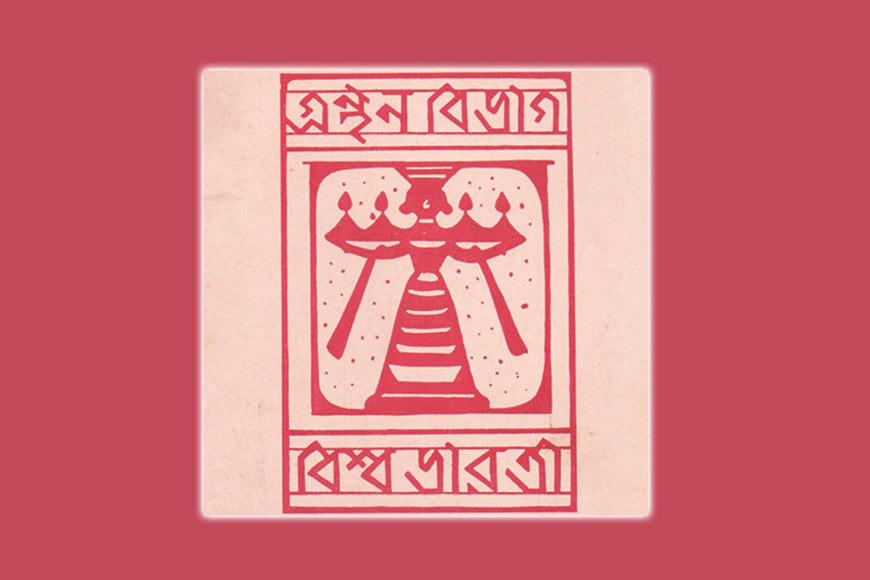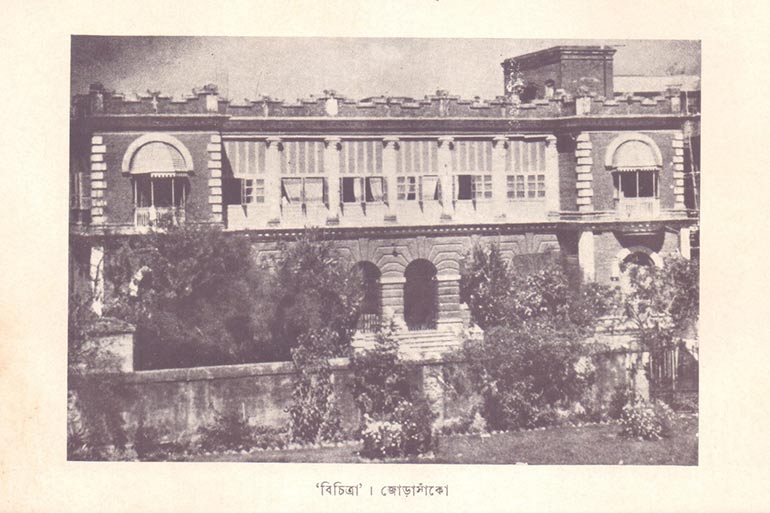Tagore’s grandson Nitindranath and century old Visva-Bharati Publishing Division

The dream called Santiniketan was not just about world poet Rabindranath Tagore. It was also about Visva Bharati Publishing house that over a century published some of the most prized books of India. As the house celebrates its centenary year, GB brings you an exclusive 2-part series on the publishing division of Visva Bharati
Much before Visva Bharati publication department was conceived, a printing press was set up in Santiniketan. Substantial funds were required to run the institution at Santiniketan and Rabindranath was bogged down by liquidity crisis. He explored different avenues to raise money. During this period, he travelled abroad extensively delivering lectures. On January 8, 1917, Rabindranath addressed audience at the Oliver Theatre in Lincoln, Nebraska, and spoke on Nationalism. The audience loved his speech so much that at the end of the seminar, they gifted Tagore a printing machine for the students of Santiniketan. The name of the machine was Lincoln Press and it was embossed on the top of the apparatus. Tagore was elated. He brought the machine back to Santiniketan and launched Santiniketan Press. Geet Panchashika, published in 1918, was the first book that emerged from the stables of Santiniketan Press. The book was a compilation of notations of Tagore’s songs. Dinendranath Tagore aka Dinu Thakur, Rabindranath’s beloved grandson, was entrusted with the charge of the press. In the initial days of printing, Tagore’s first play, ‘Basanta’ was published from this press in 1923. In 1925, a ‘Sankolon’ (anthology) of Tagore’s works comprising essays, letters, diaries and stories was published.
Rabindranath Tagore wanted Santiniketan Press to be the vehicle for printing and publishing all books of Visva-Bharati. Nevertheless, the work of the bibliography department was shifted to 210, Cornwallis Street in Kolkata and to 'Bichitra' house in Jorasanko, mainly to facilitate procuring and distribution of raw materials like paper, ink etc. and centralize the functions of binding, marketing, etc. A new era of printing began in India.
Rabindranath envisioned a rich and exclusive genre in the titles published from Visva Bharati Publication. The books published from Visva Bharati Granthana Vibhaga have a distinct graphic style. They all have a simple, minimalist clean flawless look with the titles written against ochre cover. This was how the poet had conceptualized books to look and his vision was carried forward by his band of competent successors.
Rabindranath was gradually abandoning the path of ornamentation in books. In his essay, ‘Library, he writes, “Here (in the book) the language is silent, the flow is fixed, the immortal light of the human soul is fettered in black letters and imprisoned in paper.” He wanted to free his writings from this imprisonment. He was inspired by the Japanese style and wanted to incorporate it in the publication of books. He wrote, “The intricate craftsmanship of a Japanese sword is not ostentatious because the scabbard that holds the sword is always white, a neutral colour. That is because they are artistically inclined.”
Rabindranath was progressively moving away from elaborate, ornate designs of book printing. He was very specific when he instructed Kishorimohan Santra, assistant secretary of the publication department, saying "I will not embellish the book. Only the title, ‘Bithika’ should appear in white letters on its cover.” The theme of the book itself is its accessory, with the title of the book and its author’s name appearing against a light ochre cover spearheaded a new era in the world of printing and publication in India. Books published from Visva Bharati Granthana Vibhaga carved out a distinct and niche identity for its products in the world of publication. Rabindranath wanted to do away with all embellishments on the cover and he even scrapped off ‘Sri,’ a prefix added before the name of the author. This further enhanced the sober look of the cover.
Tagore was exposed to the changing trends and technological advancements in printing technology during his travels to different European countries. He sent his grandson Nitindranath to Germany to learn printing technology. In a letter from Germany, Nitindranath wrote to Rabindranath, "I am now learning the tools of the trade in a good printing press here. ... Their forte is color printing.” Nitindranath died prematurely and Visva Bharati publication department could not utilize his experience. However, Prasanta Chandra Mahalanobis pitched in and promoted the poet’s vision. He was directly involved in mechanically embossing the titles of ‘Lekhon’ and ‘Boikali’ in Rabindranath’s handwriting on the book covers. He arranged for importing a modern printing machine for Santiniketan Press from Berlin. After it was installed, ‘Sphoolinga,’ an anthology of Tagore’s poems, was printed from Santiniketan Press.
Along with Prasanta Chandra Mahalanobis, the Visva Bharati publication department has been enriched by the tireless endeavours of Rabindranath’s admirers and followers including Kishorimohan Santra, Pulin Bihari Sen and Charuchandra Bhattacharya. If we look at the preparatory measures undertaken for a letter-perfect publication of all the volumes of ‘Rabindra Rachanabali’, what strikes one is the immense dedication and perseverance of those involved in the mammoth project. Rabindranath could not see the entire works during his lifetime but the helm was taken over by Pulin Bihari Sen, whose sincere and devoted labour made it possible for all the volumes of Rabindra Rachanabali to see the day of light.
Rabindranath was keen to promote and spread mass education and to fulfill his wish, the publication department undertook two projects namely, 'Lokshiksha Granthamala' and 'Vishwavidya Sangraha' and published series of books on these two topics. There are 13 books under the 'Lokshiksha Granthamala' and 133 under 'Vishwavidya Sangraha.' After Rabindranath’s demise, Charuchandra Bhattacharya and Pulin Bihari Sen continued the work.
 The Publishing Division was shifted to 'Bichitra' house in Jorasanko
The Publishing Division was shifted to 'Bichitra' house in Jorasanko
The Visva-Bharati Publication (Visva Bharati Granthana Vibhaga) has completed its centenary year. The organization was a harbinger of modernity in Indian printing and publishing industry not only in Bengal but the entire country. Even after Rabindranath’s death, his successors ensured that the publication would remain right at the top in the business. But how is the state of the publication at present? Santiniketan Press, which is intrinsically linked with the memory of Rabindranath, has downed shutters for good. From January 1, 2002, the most-zealously-guarded copyright in Indian literary history, monitoring the works of Rabindranath Tagore, expired and Visva-Bharati University ceased to enjoy 'sole authority' over Tagore's work. Any publisher or individual could print Tagore's works and several publishers hit the market, ending Visva-Bharati's monopoly. Books of other publications are available at a lower price than Visva-Bharati. Apart from this, there is a problem of out-of-print in the Visva-Bharati Bibliography Department. Although the books of other publications are worthless, there are numerous spelling mistakes. All those books are tasteless and full of unnecessary glare.
Since the withdrawal of the copyright, the library has lost the exclusive right to publish Rabindranath's books, as a result of which they have been increasingly lagging behind in competition with other publishing organizations. One of the main reasons for this is that books of publishing organizations. One of the main reasons for this is that books of other publications are available at a lower price than Visva-Bharati. Also, Visva Bharati publication is mired by issues like reprinting out-of-print editions. Although the books of other publications are available at a cheaper rate but glaring printing errors, spelling mistakes and garish looks are aesthetically insufferable.
Rabindranath had a specific vision when he set up the publication department and after his demise, his followers carried on the task devotedly but once the copyright expired, all his labour seemed to go in vain. Aficionados of Rabindranath’s works still look for his titles published from Visva Bharati. So, authorities in charge of Visva Bharati should buck up and take measures to revive the lost glory of the publication department. This year Visva Bharati completes a century but the opportunity to celebrate this glorious event was given a slip. May the history of Visva Bharati Publication remain as a beacon of light in the publishing world for generations to come.










